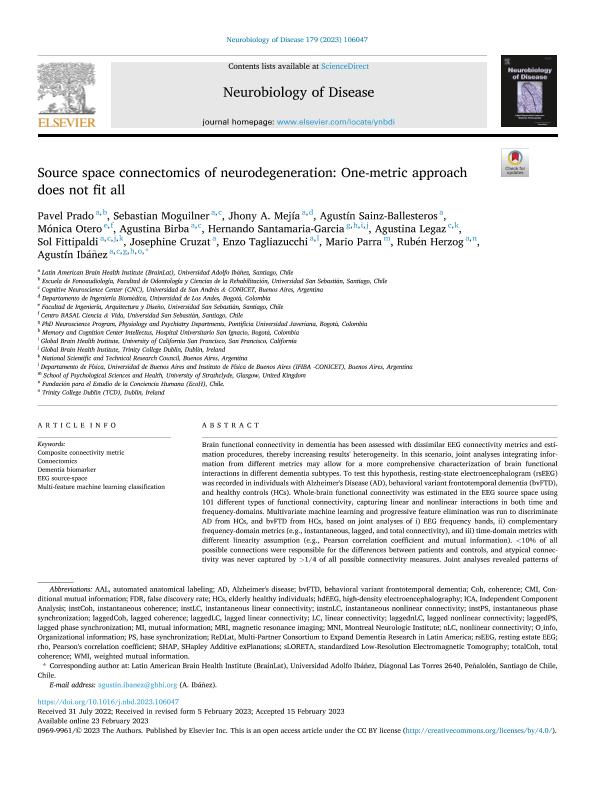Artículo
Source space connectomics of neurodegeneration: One-metric approach does not fit all
Prado, Pavel; Moguilner, Sebastian Gabriel; Mejía, Jhony A.; Sainz Ballesteros, Agustín; Otero, Mónica; Birba, Agustina ; Santamaria Garcia, Hernando
; Santamaria Garcia, Hernando ; Legaz, Agustina
; Legaz, Agustina ; Fittipaldi, María Sol
; Fittipaldi, María Sol ; Cruzat, Josephine; Tagliazucchi, Enzo Rodolfo
; Cruzat, Josephine; Tagliazucchi, Enzo Rodolfo ; Parra, Mario; Herzog, Rubén; Ibañez, Agustin Mariano
; Parra, Mario; Herzog, Rubén; Ibañez, Agustin Mariano
 ; Santamaria Garcia, Hernando
; Santamaria Garcia, Hernando ; Legaz, Agustina
; Legaz, Agustina ; Fittipaldi, María Sol
; Fittipaldi, María Sol ; Cruzat, Josephine; Tagliazucchi, Enzo Rodolfo
; Cruzat, Josephine; Tagliazucchi, Enzo Rodolfo ; Parra, Mario; Herzog, Rubén; Ibañez, Agustin Mariano
; Parra, Mario; Herzog, Rubén; Ibañez, Agustin Mariano
Fecha de publicación:
04/2023
Editorial:
Academic Press Inc Elsevier Science
Revista:
Neurobiology of Disease
ISSN:
0969-9961
Idioma:
Inglés
Tipo de recurso:
Artículo publicado
Clasificación temática:
Resumen
Brain functional connectivity in dementia has been assessed with dissimilar EEG connectivity metrics and estimation procedures, thereby increasing results' heterogeneity. In this scenario, joint analyses integrating information from different metrics may allow for a more comprehensive characterization of brain functional interactions in different dementia subtypes. To test this hypothesis, resting-state electroencephalogram (rsEEG) was recorded in individuals with Alzheimer's Disease (AD), behavioral variant frontotemporal dementia (bvFTD), and healthy controls (HCs). Whole-brain functional connectivity was estimated in the EEG source space using 101 different types of functional connectivity, capturing linear and nonlinear interactions in both time and frequency-domains. Multivariate machine learning and progressive feature elimination was run to discriminate AD from HCs, and bvFTD from HCs, based on joint analyses of i) EEG frequency bands, ii) complementary frequency-domain metrics (e.g., instantaneous, lagged, and total connectivity), and iii) time-domain metrics with different linearity assumption (e.g., Pearson correlation coefficient and mutual information). <10% of all possible connections were responsible for the differences between patients and controls, and atypical connectivity was never captured by >1/4 of all possible connectivity measures. Joint analyses revealed patterns of hypoconnectivity (patientsHCs) in both groups was mainly identified in frontotemporal regions. These atypicalities were differently captured by frequency- and time-domain connectivity metrics, in a bandwidth-specific fashion. The multi-metric representation of source space whole-brain functional connectivity evidenced the inadequacy of single-metric approaches, and resulted in a valid alternative for the selection problem in EEG connectivity. These joint analyses reveal patterns of brain functional interdependence that are overlooked with single metrics approaches, contributing to a more reliable and interpretable description of atypical functional connectivity in neurodegeneration.
Archivos asociados
Licencia
Identificadores
Colecciones
Articulos(INFINA)
Articulos de INST.DE FISICA DEL PLASMA
Articulos de INST.DE FISICA DEL PLASMA
Articulos(SEDE CENTRAL)
Articulos de SEDE CENTRAL
Articulos de SEDE CENTRAL
Citación
Prado, Pavel; Moguilner, Sebastian Gabriel; Mejía, Jhony A.; Sainz Ballesteros, Agustín; Otero, Mónica; et al.; Source space connectomics of neurodegeneration: One-metric approach does not fit all; Academic Press Inc Elsevier Science; Neurobiology of Disease; 179; 4-2023; 1-16
Compartir
Altmétricas



